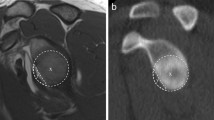Abstract
Purpose
We evaluated the role of computed tomography (CT) for quantifying glenoid bone defects in patients with anterior glenohumeral instability and assisting in planning the most appropriate type of surgery.
Materials and methods
From January to November 2006, 93 patients were studied by spiral CT with multiplanar reconstructions (MPR) for recurrent posttraumatic anteroinferior instability, chronic multidirectional instability and recurrent glenohumeral dislocation after surgical stabilisation.
Results
Quantitative CT enabled us to measure bone defects of the anteroinferior glenoid in terms of area (mm2) or surface percentage. Glenoid osseous defects were classified as small (<15%), medium (15%–20%), and large (>20%).
Conclusions
CT quantification of glenoid bone loss is very accurate as well as rapid, simple and easily reproducible. CT therefore provides an important contribution to preoperative selection of patients, assisting in directing those with <20% bone loss towards arthroscopic capsular repair.
Riassunto
Obiettivo
Valutare l’efficacia della TC nel quantificare esattamente il deficit osseo glenoideo in pazienti con instabilità gleno-omerale antero-inferiore, per la pianificazione del corretto approccio chirurgico.
Materiali e metodi
Nel periodo compreso tra gennaio e novembre 2006, sono stati sottoposti a TC spirale e successive elaborazioni MPR (Multi-Planar-Recostruction), 93 pazienti giunti alla nostra osservazione per instabilità recidivante post-traumatica anteroinferiore, instabilità cronica multidirezionale e recidiva di lussazione dopo intervento di stabilizzazione.
Risultati
La valutazione quantitativa ha permesso di calcolare con esattezza il deficit osseo del bordo glenoideo antero-inferiore in termini di area (espressa in mm2) o di percentuale di superficie. Le dimensioni del difetto sono stato classificate come: piccolo (<15%), medio (tra il 15% ed il 20%) e grande (>20%).
Conclusioni
La metodica da noi utilizzata rende possibile quantificare con estrema precisione il deficit osseo, con una tecnica semplice, rapida e facilmente riproducibile, fornendo così un contributo fondamentale nella selezione pre-operatoria dei pazienti, indirizzando verso l’intervento di capsuloplastica artroscopica i pazienti con un difetto osseo inferiore al 20%.
Similar content being viewed by others
References/Bibliografia
Russo R (2000) Instabilità anteriore. Chirurgia della Spalla. Eds Momento Medico, Salerno
Savoie FH 3rd (1997) Arthoscopy management of posterior shoulder intability. Op Techn in Sports Med 5:226–232
Bernageu J (1995) The labrum glenoidale. Ann Radiol 38:266–274
Blum A, Coudane H, Mole D (2000) Gleno-humeral instabilities. Eur Radiol 10:63–82
Griffith JF, Antonio GE, Tong CW, Ming CK (2003) Anterior shoulder dislocation: quantification of glenoid bone loss with CT. AJR Am J Roentgenol 80:1423–1430
Sugaya H, Moriishi J, Dohi M et al (2003) Glenoid rim morphology in recurrent anterior glenohumeral instability. J Bone Joint Surg Am 85:878–884
Bigliani LU, Newton PM, Steinmann SP et al (1998) Glenoid rim lesions associated with recurrent anterior dislocation of the shoulder. Am J Sports Med 26:41–45
Burkhart SS, De Beer JF (2000) Traumatic glenohumeral bone defects and their relationship to failure of arthroscopic Bankart repairs: Significanse of the inverted-pear glenoid and the humeral engaging Hill-Sachs lesion. Arthroscopy 16:677–694
Itoi E, Lee SB, Berglund LJ et al (2000) The effect of a glenoid defect on anteroinferior instability of the shoulder after Bankart repair: A cadaver study. J Bone Joint Surg Am 82:35–46
Sugaya H, Moriishi J, Kamisawa I, Tsuchya A (2006) Arthroscopic osseous bankart repair for chronic recurrent traumatic anterior glenohumeral instability. Surgical technique. J Bone Joint Surg Am 88[Suppl 1]:159–169
Porcellini G, Campi F, Paladini P (2002) Arthroscopic approach to acute bony Bankart lesion. Arthroscopy 18:746–749
Russo R, Ciccarelli M, Giudice G, Vernaglia Lombardi L (2003) Capsuloplastica artroscopica nell’instabilità antero-inferiore di spalla: risultati clinici con follow-up 1–3 anni. Artroscopia 4:157–164
Russo R, Giudice G, Ciccarelli M et al (2005) Anterior-inferior shoulder instability: treatment based on the Thal method. Chir Organi Mov 90:137–143
Itoi E., Lee SB, Amranii KK et al (2003) Quantitative assessment of classic anteroinferior bony Bankart lesions by radiography and computed tomography. Am J Sports Med 31:112–118
Willems WJ, Huysmans PE (2003) Quantification of a glenoid defect with 3D TC 3D RMN: a cadaveric study. SECEC Abstract book Oral 7: shoulder instability 118
Burkhart SS, De Beer JF (2002) Quantifying glenoid bone loss arthroscopically in shoulder instability. Artroscopy 18:488–491
Burkhart SS, Lo IK (2004) The inverted pear glenoid: an indicator of significant glenoid bone loss. Arthoscopy 20:169–174
Baudi P, Righi P, Bolognesi D et al (2005) Come identificare e quantificare il deficit osseo glenoideo. Chir Organi Mov 90:145–152
Author information
Authors and Affiliations
Corresponding author
Rights and permissions
About this article
Cite this article
d’Elia, G., Di Giacomo, A., D’Alessandro, P. et al. Traumatic anterior glenohumeral instability: quantification of glenoid bone loss by spiral CT. radiol med 113, 496–503 (2008). https://doi.org/10.1007/s11547-008-0274-5
Received:
Accepted:
Published:
Issue Date:
DOI: https://doi.org/10.1007/s11547-008-0274-5




